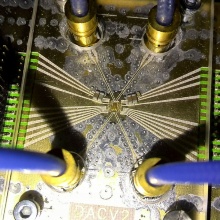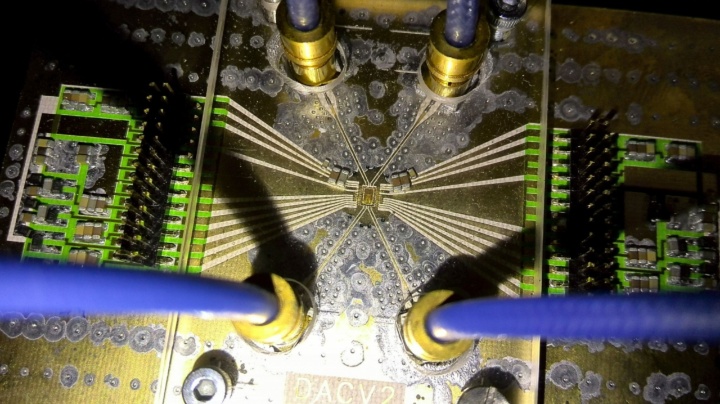Transmitting more and more internet traffic on existing fiber networks without spending money for new fiber links – that is the dream of the telecommunication industry and of many politicians. Scientists of the Institute of Electrical and Optical Communications Engineering (INT) from the University from Stuttgart have done a big step forward towards this vision: They are presenting the world’s fastest electronic digital-to-analog converter featuring 100 billion conversions per second (100 GS/s) on the International IEEE (Institute of Electrical and Electronics Engineers) Radio Frequency Integrated Circuit Symposium (RFIC) in Tamapa Bay / Florida on June, 2 nd, 2014*. Such converters – regarded as key components for the future internet – receive digital data words from the internet routers and convert them to analog voltage values which again control the optical modulators at the interface to the optical fiber links.
The global high-speed data network is the backbone of the internet. This network consists of network hubs with electronic routers and switches that are interconnected via long-haul data links. The long-haul data links consist of bundles of optical fibers on which the information is transmitted fast and with low attenuation in the form of modulated light. The data volume transmitted over the net is increasing exponentially since many years. Nevertheless the network providers try to avoid the costly installation of new fiber links between the network hubs. Instead they always try to increase the data throughput on existing links, first. Nowadays, the data throughput on existing links may only be increased further by complex modulation formats for which the light wave intensity as well as the light wave phasing in the optical fiber is changed very quickly. High-speed and high resolution digital-to-analog converters are required at the interface of the internet routers to the optical fiber links to enable this complex modulation formats. Due to the ever growing data traffic in the internet the requirements on conversion rate and resolution are increasing, too.
The INT engineers have designed the world’s fastest digital-to-analog converter in an advanced 28 nm CMOS technology as a highly integrated mixed-signal integrated circuit (IC) to satisfy the needs described above. Mixed-signal circuits contain analog as well as digital circuitry that interact very closely and thus serve as interface between the digital and analog parts of modern data transmission systems. To implement the extremely high conversion rate of 100S/s four converter cores have been placed on the chip in a time- and geometrically interleaved structure to provide for a new output voltage sample every 10 picoseconds. The outputs of the four converter cores have been embedded into a so-called artificial transmission line to provide for a large output bandwidth in spite of the parallel placement of four cores at the single output. The capacitive loads of the converter stages form a travelling wave structure together with appropriately dimesioned inductors, resulting in a large output bandwith overall structure.
During the design of the converter the INT scientists have built on technical expertise that they have gained during the project “100GET”, which has been funded by the Federal Ministry of Education and Research (BMBF). That research project aimed at a data throughput of 100 Gbit/s per optical fiber wavelength channel. By using the presented new converter with a conversion rate of 100 GS/s and a nominal resolution of 8 bit the data throughput may be increased to 400 Gbit/s per optical fiber wavelength channel.
Fast and broadband digital-to-analog converters as the presented one will also enable new test and measurement applications. Examples are arbitrary waveform generators that provide almost any output signal waveform as well as future ultra-broadband wireless data links with a throughput of more than 100 Gbit/s.
*Original publication: H. Huang, J. Heilmeyer, M. Grözing, M. Berroth: “An 8-bit 100-GS/s distributed DAC in 28-nm CMOS”, IEEE Radio Frequency Integrated Circuits Symposium (RFIC) 2014, Tampa Bay, Florida, June 1-3, 2014, WWW: http://rfic-ieee.org/
Further information:
Dr. Markus Grözing, Universität Stuttgart, Institut für Elektrische und Optische Nachrichtentechnik (INT), Phone: 0711/685-67921, Email: m.groezing [at] int.uni-stuttgart.de.
Prof. Dr. Manfred Berroth, Universität Stuttgart, Institut für Elektrische und Optische Nachrichtentechnik (INT), Phone: 0711/685-67922, Email: berroth [at] int.uni-stuttgart.de.
Andrea Mayer-Grenu, Universität Stuttgart, Abt. Hochschulkommunikation, Phone: 0711/685-82176, Email: andrea.mayer-grenu [at] hkom.uni-stuttgart.de.



